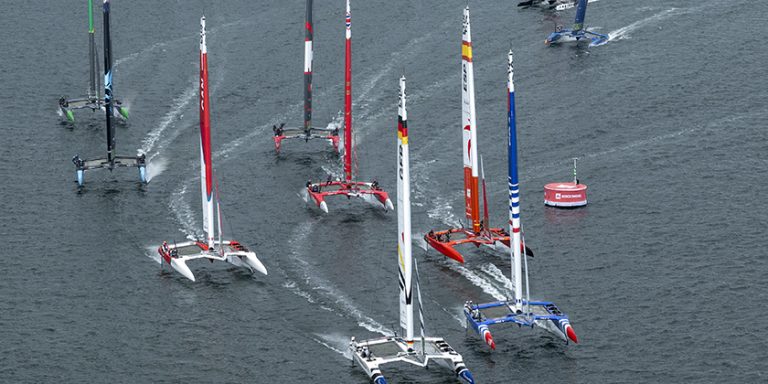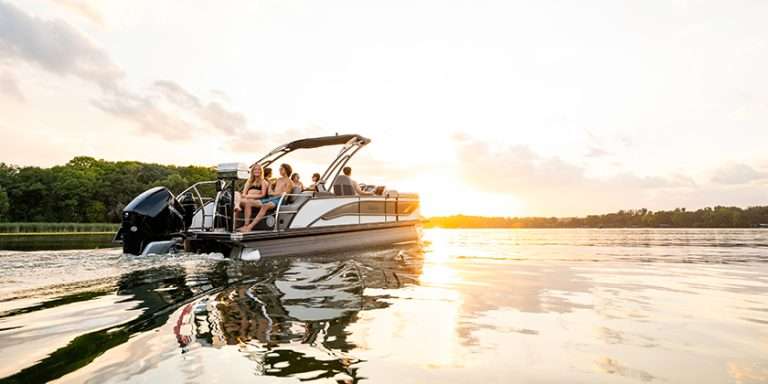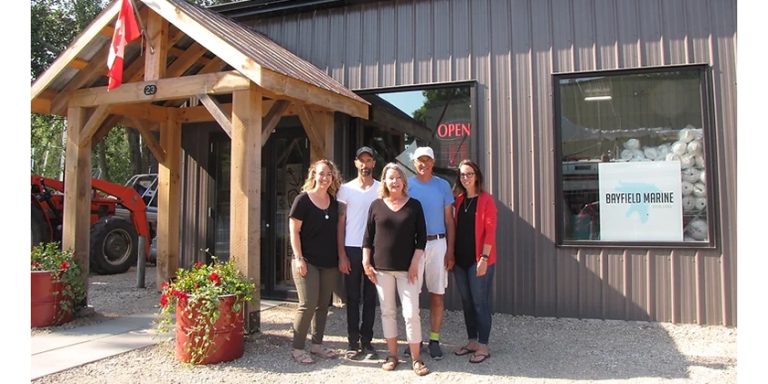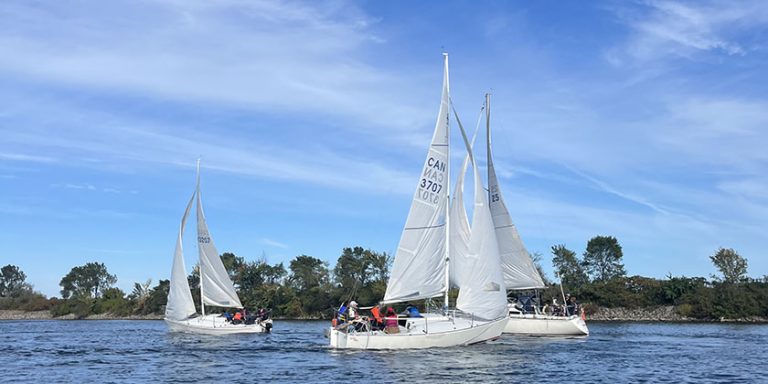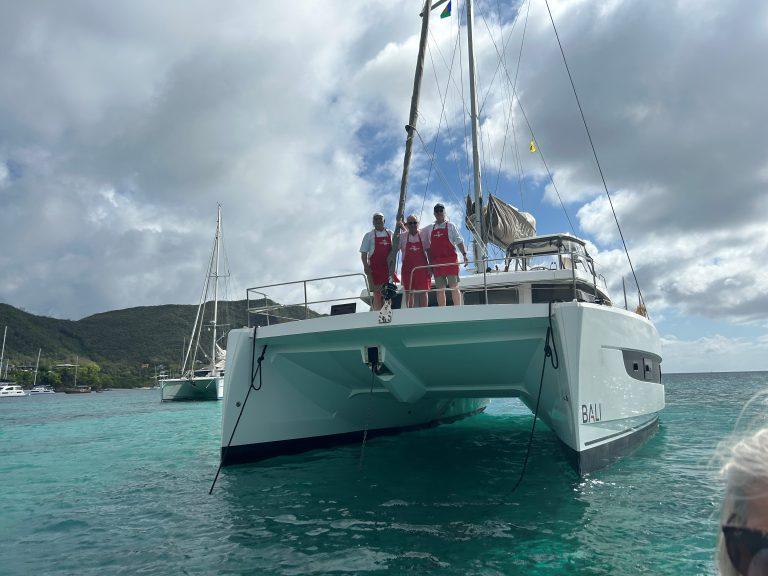Gimli Yacht Club
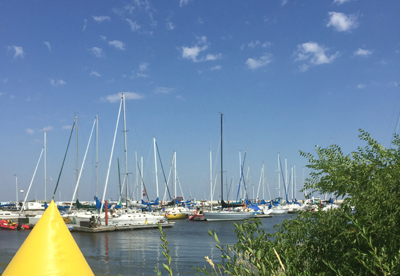
 By Katherine Stone
By Katherine Stone
Now the harbour is filling with predominantly keelboats.
As I scanned the race committee boats being used for the Canada Summer Games, I found it quite curious that the mark and pin boats were actually fishing boats. Wondering why this was began my adventure of delving into the history of Gimli, Manitoba, its yacht club, and the Icelandic culture.
Although Icelanders actually knew about the existence of Canada in the late tenth century, there was no large-scale emigration until the late 19th century. Conditions in Iceland had become rather horrific at that time due to a series of bad winters and the eruption of a number of active volcanoes. By 1875, conditions were so poor that living anywhere other than Iceland would be preferable. The Canadian government distributed a booklet called Nya Island/Kanada (New Iceland in Canada),which declared the wonderful benefits of starting a new life in Canada and granted land along the shores of Lake Winnipeg.
Sigtryggur Jonasson set out on a journey to find a suitable site to establish New Iceland in northern Iceland. Many factors had to be considered; the area needed to be free from natural disasters, isolated from the rest of Manitoba so that they could live in peace, have good soil and farm land, have easy access to a lake, and be similar enough to Iceland so that they could continue their trades (fishing and farming). It was just a short little list. The passage to Canada was expensive and dangerous; many died on the voyage. With time on their hands during the long voyage, the Icelanders decided on the name of ‘Gimli’ (Icelandic for ‘Paradise’), but not all were prepared for the harsh Canadian winter. Those who survived were hard-working, tough, and willing to start over in a new land. Only nine days after landing in Willow Point (70km north of Winnipeg on the west side of Lake Winnipeg), which is now Gimli, they dispatched a message to the Manitoba government asking for permission to establish a school.
 The members maintain beautiful flower containers and
The members maintain beautiful flower containers and
beds around the clubhouse.
At the time, there were scattered settlements of peaceful Swampy Cree Indigenous peoples living in the area. In true Icelandic fashion, a mutual agreement was reached where they each respected each other’s territory and left the other alone. However, the arrival of smallpoxwith another large group of settlers from disaster-stricken Iceland was to decimate the Icelandic and Indigenous population for those who were not vaccinated.
After the hardship of the smallpox epidemic, the Icelanders needed strong leadership. A constitution was finalized in 1878 recognizing New Iceland as a separate nation with full control of immigration, taxation, and legal matters. This lasted almost ten years. The growing freighting, logging, lumbering, and fishing industries flourished near Lake Winnipeg, and the farmers learned proper techniques for crop cultivation. In the late 1890s, an Icelandic steamboat, ‘Lady of the Lake,’ was constructed and Tergesen’s general store was established; it still operates today in Gimli.
 Floating docks and ramps make for easy access to boats.
Floating docks and ramps make for easy access to boats.
By 1906, the isolation of Gimli had evaporated with the arrival of the railroad, which brought easy transportation, commerce, and tourists. With 1,750kmofshoreline and 24,514 sq.km of warm water, Lake Winnipeg has always brought welcome relief to Manitobans from their surprisingly hot summers. In over 100 years, the heart and soul of the Gimli community has not changed for Icelanders. In true form, the Icelandic Festival of Manitoba, ‘Islendingadagurinn,’ has been celebrated since 1890, and officially moved to Gimli in 1932. The traditions, parade, food, and culture have changed very little and are still celebrated on August 2nd. This date was chosen for the farmers as seeding was over and the harvest had not yet begun.
With the construction of the RCAF Flying Training School (and after the war as a jet fighter training school) and air base during WWII, Gimli’s population surged again. British doctors came over after WWII and brought the pastime of sailing with them. In 1967, Winnipeg was chosen as the site for the Pan Am Games. Fed by the Lake of the Woods and the Winnipeg, Saskatchewan, and Red Rivers, Lake Winnipeg was the perfect spot for competitive sailing. At the completion of the games, the sailing venue was turned over to the town,which wanted to turn it into a fishing plant. After two years of negotiations with the town and the Manitoba Sailing Association, Gimli Yacht Club(GYC) became a reality in 1969. Already in place was the clubhouse, finger docks, and protective wharf. What a way to start a boating club – all the amenities, but very few sailors!
 A legacy of the Pan Am Games in 1967 – club prepares for the 2017 Canada Games.
A legacy of the Pan Am Games in 1967 – club prepares for the 2017 Canada Games.
The Pan Am games became a launch pad for competitions and the club hasn’t looked back since, hosting numerous prestigious events such as the Fireball Nationals, Western Canada Games,SailWest, U19 Canadian Youth Championships, North American Hobie Championships, Women’s Nationals, Laser II Nationals and North Americans, Laser Nationals and North Americans, World Board Sailing Championships, and this past summer, the Canada Games. The Manitoba Centennial Cup was presented to the GYC by the Manitoba Sailing Association in 1970 for an open regatta to celebrate the 100th birthday of the Province of Manitoba and it has been held at GYC every year since. They also host regular Wednesday night around-the-cans racing, which is very popular.
As time went on, the handful of sailors turned into hundreds. Dinghy sailors ruled the roost with Lightnings and Albacores followed by Tumbleweeds (a fiberglass version of the Mirror dinghy). With the rough, square waves found on the lake, stable and rugged boats were a necessity. With the modifications done to the harbour entrance in 1983-84, lake swells from northeast gales were no longer a problem and keelboats expanded to become the predominant fleet.Although members now mainly come from Winnipeg, about twenty percent of the members are still local Gimli residents and Icelanders of Nordic blood.
The clubhouse features wheelchair access from both sides, a large deck for dining alfresco and watching the action in the harbour and along the wharf, a kitchen, dining room, showers, washrooms, lockers, and a classroom for sail training. The beach (provided from hosting the Western Canada Games in 1991) allows for an easy launch for dinghies. The finger docks provide water and electrical hook-ups. The South basin was added to help host the second Pan Am Games in 1999, and to accommodate more keelboats. It’s referred to as the Hamptons (because it is quieter and you go south to the Hamptons!).The public marina is located right next door where there is an offering of further docks, pump-outs, gas, diesel, a crane, boat launch ramp, and winter storage.The best thing is that it’s only a short walk into town for ice cream and the best lightly battered whitefish, gold eye, or pickerel ever!
 The spacious deck is excellent for informal outdoor eating and socializing.
The spacious deck is excellent for informal outdoor eating and socializing.
Because the Icelandic fishermen were very protective of their nets and the lake was seen as a place to work, there was always a bit of tension between the sailors and fishermen. However, being Icelandic, they were open to compromise and the two groups have a long history of working together. To that end, the fishermen have always donated their boats as mark and pin boats for major championships, including this year’s Canada Games. They were even onboard to enjoy the camaraderie and work of hauling anchors for the inflatable marks.
Commodore Charlie Burns is enthusiastic when he talks about the culture and lure of the Midwest.
“There are wilderness shores no matter where you sail. It’s not crowded and there are no city lights to guide you home, except the northern lights at the end of August. We’re in the heart of the Prairies with a harsh climate, but in the harshness there is beauty. Because the lake is so large, you can see the curvature of the earth on the horizon.The further north you sail, the more it becomes like Muskoka, with less sediment in the water. In the winter, we get four feet of ice over the lake with icebridges, and the earth quakes from the ice cracking. The people are in touch with nature and what is real. Prairie common sense and self-reliance prevail. “

The yacht club burgee reflects their icelandic heritage.
The members basked in the warmest summer in decades to enjoy their 50th birthday in 2017. They could be found using the barbeques on Saturdays or after racing on Wednesday nights, enjoying each other’s tales of cruising, racing tactics, tall fish tales, or just plain enjoying time with family and friends. One thing that I certainly took home after the Canada Games was that this is a club with tremendous camaraderie and a volunteer spirit that’s reminiscent of their forefathers’ legacy.
Gimli Yacht Club; 95 1st Avenue; Gimli, Manitoba R0C 1B0 204-642-5961 www.gimliyachtclub.com


